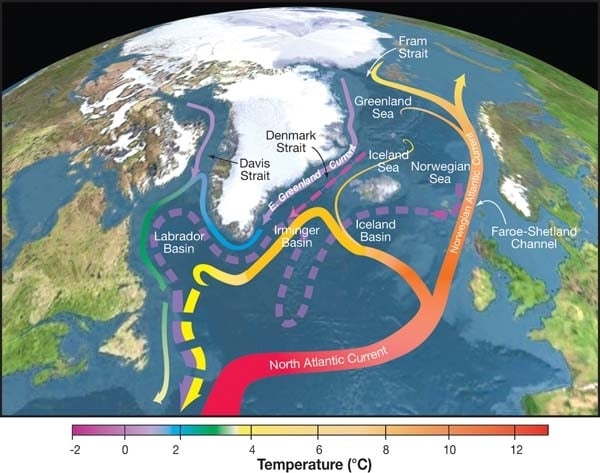
© Emiliano Arano/Pexels
L’Atlantic Meridional Overturning Circulation (AMOC) or meridian circulation Atlantic overturning current in French, is an ocean current essential for regulating the global climate. Unfortunately, the latter is in serious danger of disappearingA study led by Emma Smolders and colleagues at Utrecht University in the Netherlands simulated that this system could well collapse before the end of our century. The probability of this happening is quite high, since their results indicate that the AMOC would have a 59% chance of bowing out before 2050 (with a margin of error of 17%).
Such a scenario would completely disrupt the Atlantic marine ecosystems and its repercussions on global climate conditions would be dramatic.
The AMOC: a key pillar of the global climate
The AMOC current, although Although relatively unknown to the general public, plays a vital role in the thermal regulation of our planet. This ocean flow carries warm waters from the Gulf of Mexico to the shores of Western Europe, creating a milder climate than in countries at similar latitudes. In this way, Madrid and New York, like London and Moscow, share close latitudes, but enjoy radically different climates thanks to the beneficial influence of the AMOC.
The mechanism underlying this current is based on a delicate mechanism: as it heads north, seawater evaporates, increasing the salinity and density of the residual water. This water, which has become denser, plunges into the depths of the Atlantic, reaching the polar regions, thus initiating a cycle of return to the tropics. This age-old process is vital for the redistribution of heat and nutrients within the oceans. Unfortunately, global warming threatens this complex ecosystem, disrupting the fragile balances of salinity and density that are essential to its sustainability.

Topographic map of the Nordic Seas and subpolar basins showing surface currents (solid lines) and deep currents (dotted lines) contributing to the AMOC © R. Curry, Woods Hole Oceanographic Institution/Science/USGCRP.
A Looming Collapse, Without Warning Signs
Recent research by Smolders' team reveals an alarming reality: the AMOC is on the verge of a tipping point, and much sooner than previously thought. Their climate models predict “a probable collapse between 2037 and 2064 “, with a high probability that this event will occur before 2050. This projection contrasts drastically with previous assessments by the IPCC, which considered such a scenario unlikely before the dawn of the 22nd century.
200% Deposit Bonus up to €3,000 180% First Deposit Bonus up to $20,000What makes the situation all the more worrying is the likely absence of clear warning signs. Ocean surface temperatures in the subpolar North Atlantic, which are frequently analyzed to anticipate climate change, may not reveal the imminent collapse of the AMOC.
Paradoxically, the most reliable indicators may lie in the southern reaches of the Atlantic, one of the most remote regions on Earth. Careful monitoring of these areas will therefore be of paramount importance to detect any signs of an imminent tipping point.
Global consequences, well beyond Europe
The collapse of the AMOC would have repercussions well beyond European shores. In addition to a drastic cooling of North-West Europe, this phenomenon could upset ocean levels in the North Atlantic and profoundly disrupt tropical rainfall regimes in South Asia. These disruptions could trigger devastating droughts, potentially affecting millions of people.
One of the most alarming aspects of this scenario is that these consequences could manifest themselves well before humanity reaches its carbon neutrality goals. Precisely, if we manage one day to reduce atmospheric carbon levels, could this reduction revive the AMOC? If so, within what time frame is this possible. Currently, it is unfortunately impossible to answer this question. In other words, even if drastic measures were taken to reduce greenhouse gas emissions, there is no guarantee that this would be enough to prevent or reverse the damage inflicted on the AMOC.
Despite recent good news, particularly from Antarctica, the findings of this new study are another stark reminder of the urgency of the climate crisis we are experiencing. The next IPCC assessment, expected towards the end of the decade, will absolutely have to take into account the new data emerging from this research. Until then, the clock is ticking, certainly faster than we thought, and all future decisions made in the coming years will be critical to ensuring climate security.
- The AMOC is an ocean current that is critical to global thermal regulation.
- A new study has shown that it has a 59% chance of disappearing by 2050.
- The consequences for the global climate could be devastating.
📍 For Don't miss any Presse-citron news, follow us on Google News and WhatsApp.
[ ]
